Maryland Fishing Report – Feb. 20
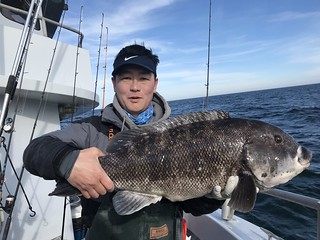
James King of Richfield, N.J., caught this 18.5-pound tautog near Ocean City, tagged it and returned it to the cold depths.
February is often thought of as a time for fishermen to keep busy by going over tackle, fly tying or attending outdoor shows. But others know there are fish out there and many know how to find them.
The preseason trout stocking program has started in earnest, and there is good fishing for yellow perch and a mixed bag of freshwater fish.
Off the coast of Ocean City, fishermen come from far and wide to pursue trophy-sized tautog.
For Chesapeake Bay anglers, the best show in town is the spawning runs of yellow perch that are developing in the tidal rivers. The yellow perch are staging in the middle to upper parts of the spawning rivers and creeks and can often be found holding in some of the deeper waters. They tend to move up on an incoming tide and will often hold below the spawning areas until water temperatures are to their liking. The smaller male yellow perch will often be the first to arrive followed by the larger females.
It is hard to beat live minnows for the larger yellow perch and the minnows can be fished under a slip bobber or retrieved slowly along the bottom with a split shot a foot or so forward of the minnow or lip hooked on a hook. A small cut piece of a live minnow will also often do well when casting a small jig. When fishing in deep water such as the lower Susquehanna River, enough sinker will be needed to hold a two hook dropper rig near the bottom. Many fishermen also have good luck by placing a small piece of felt that has been doused with anise or a favorite bait juice on a small jig. Most jigs used will be about 1/16 or 1/8 ounce and soft plastics or beetle spins often work well.
One of the fun things about yellow perch fishing is that many areas can be fished from shore and a lot of tackle and preparation is not needed. The very end of a flood tide and the beginning of an ebb tide often provides the best fishing opportunities. A light spinning outfit with 4-pound to 6-pound test monofilament line, a few small jigs and or minnows and you’re ready to go. Online, the Tide Finder link is a good place to start your yellow perch fishing adventures.
Our Click Before You Cast forecasts will return in March.
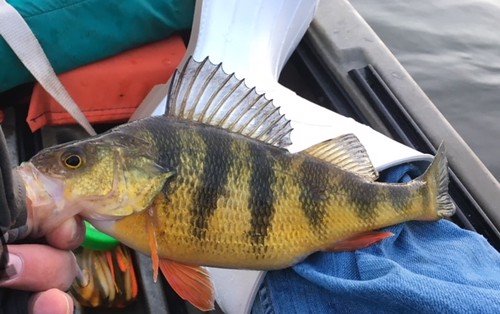
Matthew Blanchet takes a look at this nice yellow perch he caught in an upper bay tributary while fishing out of his kayak. Photo by Matthew Blanchet
Snow melt from upper watershed areas continue to fuel high flows and stained water conditions. Despite these conditions, there has been some good fishing for yellow perch in the Susquehanna River near Perryville for those using dropper rigs with small jigheads and minnows. Fishing for yellow perch has been good in the lower Northeast River from small boats, kayaks and the piers at Community Park in the town of North East.
Other tributaries to the upper bay that provide good yellow perch fishing include the Bush, Middle, Magothy, the Belle Grove Ponds off the Patapsco River, and the upper Chester River.
Fishing for catfish in the lower Susquehanna River has been good for a mix of channel and flathead catfish, and more blue cats are being caught each year. The fishing for channel catfish extends south to include all of the tidal tributaries leading to the bay. Cut bait is perhaps the most common bait used and fresh is always the best. White perch are beginning to show up in the deep holes at the mouths of most tidal rivers and can be caught on pieces of bloodworm. They make excellent fresh bait for catfish as do gizzard shad if you can procure them with a cast net. Chicken breast or chicken liver can also make a decent bait for channel catfish.
Yellow perch are being found in various areas of the upper Choptank, Tuckahoe and Nanticoke rivers. The yellow perch tend to be in the area below Denton in the Choptank, between Route 328 and Hillsboro in the Tuckahoe and near the mouth of the Marshyhope and north on the Nanticoke River. These same rivers are also holding white perch near the mouth of the rivers and lower regions in deep channel areas. Minnows and small jigs tend to be the best way to fish for yellow perch and pieces of bloodworm on a bottom rig or jig for white perch.
Fishing for blue catfish in the Nanticoke River in the Sharptown area continues to be excellent this month in the deeper channels. Fresh baits of white perch, gizzard shad or even bluegill sunfish make good baits. Channel catfish can be found in all of the tidal rivers in the region and can be caught on a variety baits such as cut bait, nightcrawlers, chicken breast and chicken liver.
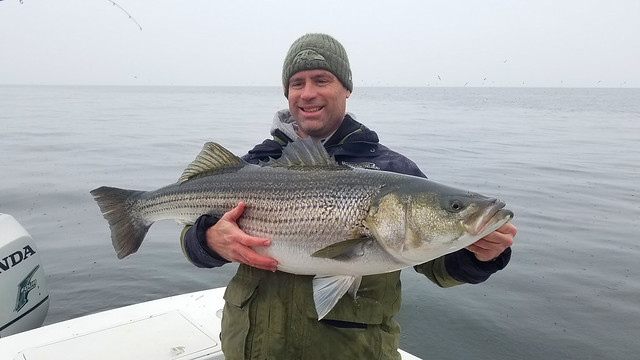
This beautiful 46-inch striped bass was caught out of Point Lookout and quickly returned after a quick picture. Photo by Jim Calvert
Perhaps the hottest ticket this month is the tidal Potomac River. The fishing for blue catfish in the region below the Wilson Bridge south has been excellent this month with many large catfish being caught. Those wishing to stock up the freezer have been catching medium sized blue catfish in the same area. Fresh gizzard shad is the most favored bait but white perch or bluegill sunfish work well also.
Some industrious souls have been venturing out into the lower Chesapeake trolling for the vanguard of the spring striped bass run and have been connecting with a few brutes. It is a bit early but there are always fish and fishermen that do not follow the norm. Striped bass will begin to filter into the bay next month in earnest but there are always some early arrivals.
Crappie fishing in the tidal Potomac has been excellent around the Wilson Bridge, marina docks and piers. Minnows or small jigs under a slip bobber has been the best way to catch them as they tend to school up around deep structure.
Yellow perch are moving up the Patuxent, Pocomoke and Wicomico rivers and can generally can be found in the upper sections of the rivers. Other good places to fish for them will be the Wicomico and Mattawoman tributaries off the tidal Potomac River later on this month.
The preseason trout stocking program has been great news for freshwater anglers who may have been suffering from a bit of cabin fever this month. Stocking crews are covering a wide range of areas, making sure that there is good trout fishing opportunities near you. The trout stocking website will show you the latest stockings the day they occur.
Put-and-take trout fishing is a wonderful experience for our young anglers so make sure you don’t leave your own or the neighborhood kids a home. A light spinning outfit, some #8 bait hooks, some split shot and a jar of Powerbait is all you need. For those looking for a little more challenge, fly fishing with weighted nymphs is a fine alternative.
Casting small spinners or spoons with an ultra-light spinning outfit is also a fun and great way to cover water looking for trout others may have missed with bait. Fly fishing with streamers or Wooley Bugger flies is another great alternative.
Reports from Deep Creek Lake and nearby reservoirs in Western Maryland tell of unsafe ice and open water in some areas. It is going to take a lot of very cold weather for it to be safe again.
There tends to be plenty of open water in the central, southern and eastern regions of the state in reservoirs and ponds. Largemouth bass are holding near deep structure and can be enticed to pick up soft plastic jigs, deep diving crankbaits and blade lures. The trick will be to present lures in smaller sizes, slow down the retrieve and keep baits close to the bottom. The bite will be subtle and often will feel like you’re snagged.
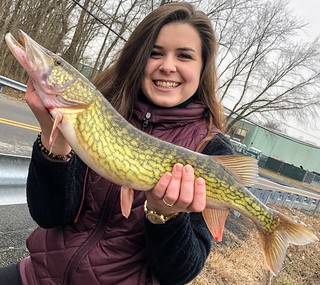
Carrissa Arillo holds up a pretty chain pickerel she caught and released in the Tuckahoe River recently. Photo by Rich Watts
Chain pickerel on the other hand, love cold water and can be found in a variety of locations. Many will be found near sunken wood along shorelines waiting to ambush anything that passes by. Most any lure will do but be careful of pickerel inhaling lures. For this reason it is a good idea to mash down the barbs on treble hooks and even snip one or two of the hooks from the treble. Always use pliers when removing hooks, to avoid those sharp teeth.
The largest of the large chain pickerel can often be found out in open water down deep near some kind of sunken structure. Old tree stumps, large logs and even a sunken small boat offer the kind of hiding places for trophy sized chain pickerel prefer. Jerkbaits or large live minnows lip hooked on a jighead are good choices for fishing this kind of structure.
Crappie don’t seem to mind cold water either and can be found schooled up near deep structure. Deep structure can be items like sunken brush, tree stumps, fallen treetops, marina docks and piers or bridge piers. A minnow or a small jig under a slip bobber is hard to beat when looking for crappie, don’t be in a hurry and work your offering slowly around the structure. Once you’ve caught one, usually there are more crappie nearby.
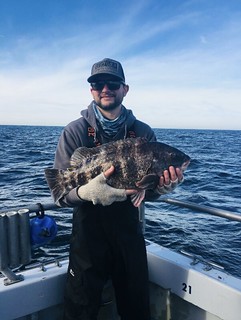
Photo by Monty Hawkens
Generally speaking, February is a month of cold water with damp and biting winds along our coastal areas. There are days when the weather breaks a bit and captains and patrons venture offshore to wreck and reef sites in search of trophy-sized tautog — which are rarely seen during the warmer months of the year. Captains report that not every trip presents calm seas and limit catches of tautog but the memory of large ones over ten pounds keep bringing fishermen and captains back for another chance. It was this time of the year that the world record tautog was caught off Ocean City a few years ago. Chunks of green crabs are generally the standard bait for tautog, but when exploring the cold depths for trophy tautog, white leggers (Jonah crabs) are the preferred bait.
“A fisherman’s ego shrinks in proportion to the actual amount of time he or she has spent in the wind, ducking hooks, being made to appear foolish by the unfathomable behavior of fish – something that in time he will no longer pretend to understand.” — Randy Wayne White
Keith Lockwood has been writing the Fishing Report since 2003 and has had a long career as a fisheries research biologist since 1973. Over the course of his career he has studied estuarine fishery populations, ocean species, and over a decade long study of bioaccumulation of chemicals in aquatic species in New Jersey. Upon moving to Oxford on the eastern shore of Maryland; research endeavors focused on a variety of catch-and-release studies as well as other fisheries related research at the Cooperative Oxford Laboratory. Education and outreach to the fishing public has always been an important component to the mission of these studies. Keith is an avid outdoorsman enjoying hunting, fishing, bird dogs, family and life on the eastern shore of Maryland.


 1-888-373-7888
1-888-373-7888 233733
233733